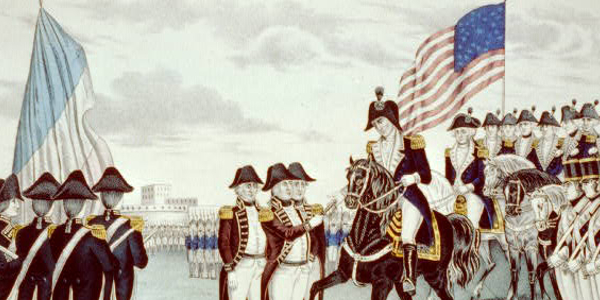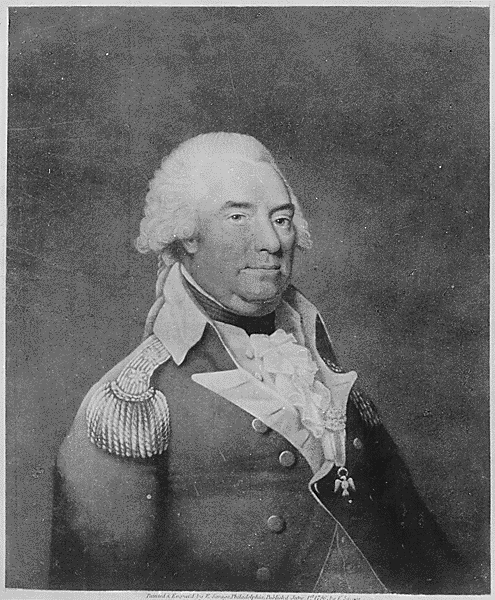Sponsor this page for $75 per year. Your banner or text
ad can fill the space above.
Click here to Sponsor the page and how to reserve your ad.
-
Timeline
1793 Detail
April 22, 1793 - George Washington signs the Proclamation
of Neutrality in the French Revolutionary Wars, where France has
already declared war on England, the Netherlands, Austria, Prussia, and
Sardinia.

The First French Republic responded to the expansion by drafting three
hundred thousand men into the army on February 24, 1793. The war was
about to expand even further and the new government of George
Washington, first President of the United States, had to make a
decision. News did not reach the states until April that Great Britain
had joined the conflict, causing Washington to race back to
Philadelphia from Mount Vernon and address the question of neutrality.
France was essentially at war with all of Europe.
There had been discussion since the start of 1793 about the position of
the United States via neutrality. The cabinet was in agreement that the
nation could not afford a conflict against either side and that
neutrality was in order. However, Secretary of State Thomas Jefferson
did not think an official proclamation was necessary; in fact, he
argued that their neutrality could be negotiated for a price. Alexander
Hamilton disagreed, pushing for an official document. When the cabinet
convened again on April 19, 1793, all four cabinet members conceded
that the proclamation was necessary.

Full Text - Proclamation of Neutrality
The Proclamation of Neutrality 1793
A Proclamation
Whereas it appears that a state of war exists between Austria, Prussia,
Sardinia, Great Britain, and the United Netherlands, of the one part,
and France on the other; and the duty and interest of the United States
require, that they should with sincerity and good faith adopt and
pursue a conduct friendly and impartial toward the belligerant Powers;
I have therefore thought fit by these presents to declare the
disposition of the United States to observe the conduct aforesaid
towards those Powers respectfully; and to exhort and warn the citizens
of the United States carefully to avoid all acts and proceedings
whatsoever, which may in any manner tend to contravene such disposition.
And I do hereby also make known, that whatsoever of the citizens of the
United States shall render himself liable to punishment or forfeiture
under the law of nations, by committing, aiding, or abetting
hostilities against any of the said Powers, or by carrying to any of
them those articles which are deemed contraband by the modern usage of
nations, will not receive the protection of the United States, against
such punishment or forfeiture; and further, that I have given
instructions to those officers, to whom it belongs, to cause
prosecutions to be instituted against all persons, who shall, within
the cognizance of the courts of the United States, violate the law of
nations, with respect to the Powers at war, or any of them.
In testimony whereof, I have caused the seal of the United States of
America to be affixed to these presents, and signed the same with my
hand. Done at the city of Philadelphia,
the twenty-second day of April, one thousand seven hundred and
ninety-three, and of the Independence of the United States of America
the seventeenth.
George Washington
April 22, 1793
After the Proclamation
Inside the United States, the Declaration of Neutrality
continued the hostilities between Jefferson and Hamilton, with
disagreement over its constitutionality, the expansion of presidential
powers, and whether being neutral in an offensive war was in conflict
with its defensive treaties with France. By December 1793, Jefferson
would resign his position as Secretary of State. Congress assisted in
the debate in 1794, when it passed the Neutrality Act, turning
Washington's policy into Congressional law. This helped establish the
precedent that the executive branch had broad powers in the area of
foreign policy.
On the external front, the intent of the declaration was better than
the outcome. Despite the historic nature of the relationship between
the United States and France, which reached back to their aid with
defeating the British in the American Revolution, it would take less
than two decades for that to erode. French ships began to confiscate
United States merchant vessels for payment for debts that the United
States owed, but refused to pay to the French First Republic, the new
government of France. An XYZ affair would occur. A Quasi War would
start. By 1798, all
French treaties with the United States would be cancelled,
and we would be at war with the French, essentially siding with the
British, with a new trade deal in tow, after they had been our enemy
during our own revolution. Yes, the vagaries of international
diplomacy, cooperation, and changing sides. By 1812, it would change
again, with the British back to adversaries, and the French part of
other treaties.
Photo above: Painting of the Battle of Valmy, September 1792, 1826,
Horace Vernet. Courtesy U.K. National Gallery via Wikipedia Commons.
Photo below: Lithograph of the Surrender
of Cornwallis troops at Yorktown to American and
French armies, 1846, N. Currier. Courtesy Library of Congress. Info
source: A Compilation of the Messages and Papers of the Presidents
Prepared under the direction of the Joint Committee on printing, of the
House and Senate Pursuant to an Act of the Fifty-Second Congress of the
United States. New York : Bureau of National Literature, Inc., 1897 via
the Avalon Project, Documents in Law, History, and Diplomacy, Yale
University Law School; Mountvernon.org; Wikipedia Commons.

Back to Index





